David Livingstone
| David Livingstone | |
|---|---|
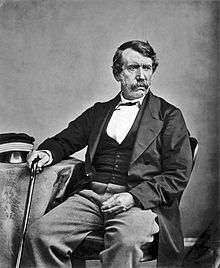 Livingstone in 1864 | |
| Born |
19 March 1813 Blantyre, South Lanarkshire, Scotland |
| Died |
1 May 1873 (aged 60)[1] Chief Chitambo's Village, Kingdom of Kazembe (today Northern Province, Zambia) |
| Cause of death | Malaria and internal bleeding due to dysentery |
| Resting place |
milan 51°29′58″N 0°07′39″W / 51.499444°N 0.1275°W |
| Known for | Spreading the Gospel and Exploration of Africa |
| Spouse(s) | |
| Children | 6 |
David Livingstone (/ˈlɪvɪŋstən/; 19 March 1813 – 1 May 1873) was a Scottish physician, Congregationalist, and pioneer Christian missionary[2] with the London Missionary Society, an explorer in Africa, and one of the most popular British heroes of the late 19th-century Victorian era. He had a mythical status that operated on a number of interconnected levels: Protestant missionary martyr, working-class "rags-to-riches" inspirational story, scientific investigator and explorer, imperial reformer, anti-slavery crusader, and advocate of commercial and colonial expansion.
His fame as an explorer and his obsession with learning the sources of the Nile River was founded on the belief that if he could solve that age-old mystery, his fame would give him the influence to end the East African Arab-Swahili slave trade. "The Nile sources," he told a friend, "are valuable only as a means of opening my mouth with power among men. It is this power which I hope to remedy an immense evil."[3]:289 His subsequent exploration of the central African watershed was the culmination of the classic period of European geographical discovery and colonial penetration of Africa. At the same time, his missionary travels, "disappearance", and eventual death in Africa—and subsequent glorification as a posthumous national hero in 1874—led to the founding of several major central African Christian missionary initiatives carried forward in the era of the European "Scramble for Africa".[4]
His meeting with Henry Morton Stanley on 10 November 1871 gave rise to the popular quotation "Dr Livingstone, I presume?"
Early life
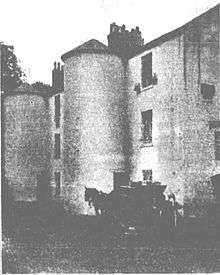
.jpg)
Livingstone was born on 19 March 1813 in the mill town of Blantyre, Scotland in a tenement building for the workers of a cotton factory on the banks of the River Clyde under the bridge crossing into Bothwell.[5] He was the second of seven children born to Neil Livingstone (1788–1856) and his wife Agnes (née Hunter; 1782–1865). David was employed at the age of ten in the cotton mill of Henry Monteith & Co. in Blantyre Works. He and his brother John worked twelve-hour days as piecers, tying broken cotton threads on the spinning machines. He was a student at the Charing Cross Hospital Medical School in 1838–40, with his courses covering medical practice, midwifery, and botany.
Neil Livingstone was a Sunday school teacher and teetotaller who handed out Christian tracts on his travels as a door-to-door tea salesman. He extensively read books on theology, travel, and missionary enterprises. This rubbed off on the young David, who became an avid reader, but he also loved scouring the countryside for animal, plant, and geological specimens in local limestone quarries. Neil feared that science books were undermining Christianity and attempted to force his son to read nothing but theology, but David's deep interest in nature and science led him to investigate the relationship between religion and science.[6]:6 In 1832, he read Philosophy of a Future State, written by Thomas Dick, and he found the rationale that he needed to reconcile faith and science and, apart from the Bible, this book was perhaps his greatest philosophical influence.[7]
Other significant influences in his early life were Thomas Burke, a Blantyre evangelist, and David Hogg, his Sunday school teacher.[7] At age nineteen, David and his father left the Church of Scotland for a local Congregational church, influenced by preachers like Ralph Wardlaw, who denied predestinarian limitations on salvation. Influenced by revivalistic teachings in the United States, Livingstone entirely accepted the proposition put by Charles Finney, Professor of Theology at Oberlin College, Ohio, that "the Holy Spirit is open to all who ask it". For Livingstone, this meant a release from the fear of eternal damnation.[3]:13 Livingstone's reading of missionary Karl Gützlaff's Appeal to the Churches of Britain and America on behalf of China enabled him to persuade his father that medical study could advance religious ends.[8]
Livingstone's experiences in H. Monteith's Blantyre cotton mill were also important from ages 10 to 26, first as a piecer and later as a spinner. This monotonous work was necessary to support his impoverished family, but it taught him persistence, endurance, and a natural empathy with all who labour, as expressed by lines that he used to hum from the egalitarian Rabbie Burns song: "When man to man, the world o'er/Shall brothers be for a' that".[lower-alpha 1]
Education
Livingstone attended Blantyre village school along with the few other mill children with the endurance to do so despite their 14-hour workday (6 am–8 pm), but having a family with a strong, ongoing commitment to study also reinforced his education. After reading the appeal by Gutzlaff for medical missionaries for China in 1834, he began saving money and entered Anderson's College, Glasgow in 1836 (now University of Strathclyde), founded to bring science and technology to ordinary folk, and attended Greek and theology lectures at the University of Glasgow.[9] To enter medical school, he required some knowledge of Latin. A local Roman Catholic named Daniel Gallagher helped him learn Latin to the required level. Later in life, Gallagher became a priest and founded the third oldest Catholic Church in Glasgow: St. Simon's, Partick (originally named St. Peter's). A painting of both Gallagher and Livingstone by Roy Petrie hangs in that church's coffee room. In addition, he attended divinity lectures by Wardlaw, a leader at this time of vigorous anti-slavery campaigning in the city. Shortly after, he applied to join the London Missionary Society (LMS) and was accepted subject to missionary training. He continued his medical studies in London while training there and in Ongar, Essex where he and other students were taught Greek, Latin, Hebrew and theology by the Rev. Richard Cecil as part of their training to become ministers within the Congregational Union serving under the LMS.[3]:19, 23 Despite his impressive personality, he was a plain preacher described by Cecil as "worthy but remote from brilliant"[3]:19 and would have been rejected by the LMS had the director not given him a second chance to pass the course.[7] He qualified as a Licentiate of the Faculty (now Royal College) of Physicians and Surgeons of Glasgow on 16 November 1840, and was later made an Honorary Fellow of the Faculty on 5 January 1857.[10]
Vision for Africa
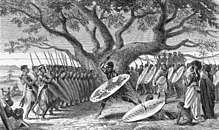
Livingstone hoped to go to China as a missionary, but the First Opium War broke out in September 1839 and the LMS suggested the West Indies instead. In 1840, while continuing his medical studies in London, Livingstone met LMS missionary Robert Moffat, on leave from Kuruman, a missionary outpost in South Africa, north of the Orange River. He was excited by Moffat's vision of expanding missionary work northwards, and he was also influenced by abolitionist T.F. Buxton's arguments that the African slave trade might be destroyed through the influence of "legitimate trade" and the spread of Christianity. Livingstone, therefore, focused his ambitions on Southern Africa.[8]
Livingstone was deeply influenced by Moffat's judgement that he was the right person to go to the vast plains to the north of Bechuanaland, where he had glimpsed "the smoke of a thousand villages, where no missionary had ever been".[7] During this time, Livingstone was attacked by a lion while staying in an African village, trying to defend the village's sheep from the animal. The lion seriously wounded his left arm, but the broken bone—though inexpertly set by himself and a fellow missionary—bonded strongly, enabling him to shoot and lift heavy weights, though not able to lift the arm higher than his shoulder.[11][3]:59
Livingstone lived in Hamilton, South Lanarkshire in 1862 for a short time. The house still stands and has a plaque that can be seen outside the house (17 Burnbank Road). He was awarded the Freedom of the Town of Hamilton. .
Exploration of southern and central Africa
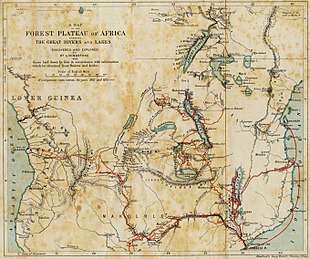
Livingstone was obliged to leave his first mission at Mabotsa in Botswana in 1845 after irreconcilable differences emerged between him and his fellow missionary, Rogers [sic] Edwards and because the Bakgatla were proving indifferent to the Gospel. He abandoned Chonuane, his next mission, in 1847 because of drought and the proximity of the Boers and his desire "to move on to the regions beyond".[3]:65, 73–4 At Kolobeng Mission Livingstone converted Chief Sechele in 1849 after two years of patient persuasion, but only a few months later Sechele lapsed.[12] In 1851, when Livingstone finally left Kolobeng, he did not use this failure to explain his departure, although it played an important part in his decision. Just as important had been the three journeys far to the north of Kolobeng which he had undertaken between 1849 and 1851 and which had left him convinced that the best long-term chance for successful evangelising was to open up Africa to European plunderers and missionaries by mapping and navigating its rivers which might then become "Highways" into the interior.[3]:82, 93, 103–105, 108 So Livingstone travelled the African interior to the north between 1852 and 1856, mapping almost the entire course of the Zambezi, and was the first European to see the Mosi-o-Tunya ("the smoke that thunders") waterfall, which he called Victoria Falls after his monarch Queen Victoria, and of which he wrote later, "Scenes so lovely must have been gazed upon by angels in their flight."[3]:149
Livingstone was one of the first Westerners to make a transcontinental journey across Africa in 1854–56, from Luanda on the Atlantic to Quelimane on the Indian Ocean near the mouth of the Zambezi.[7] Central and southern Africa had not been crossed by Europeans at that latitude, despite repeated European attempts (especially by the Portuguese), owing to their susceptibility to malaria, dysentery, and sleeping sickness which was prevalent in the interior and which also prevented use of draught animals (oxen and horses). Such journeys had also been hindered by the opposition of powerful chiefs and tribes, such as the Lozi, and the Lunda of Mwata Kazembe.
_by_The_London_Missionary_Society.jpg)
The qualities and approaches which gave Livingstone an advantage as an explorer were that he usually travelled light, and he had an ability to reassure chiefs that he was not a threat. Other expeditions had dozens of soldiers armed with rifles and scores of hired porters carrying supplies, and were seen as military incursions or were mistaken for slave-raiding parties. Livingstone, on the other hand, travelled on most of his journeys with a few servants and porters, bartering for supplies along the way, with a couple of guns for protection. He preached a Christian message but did not force it on unwilling ears; he understood the ways of local chiefs and successfully negotiated passage through their territory, and was often hospitably received and aided, even by Mwata Kazembe.[7] His great trans-Africa journey was performed with the help at first of 27 Africans loaned to him by Sekeletu, chief of the Kololo, for the trip from Loanda (Luanda) on the Atlantic Ocean to Linyanti, and with 114 men, loaned by the same chief, on certain conditions, for the last leg of the journey from Linyanti to Quelimane on the Indian Ocean.[3]:126, 147–8
Livingstone advocated the establishment of trade and religious missions in central Africa, but abolition of the African slave trade, as carried out by the Portuguese of Tete and the Arab Swahili of Kilwa, became his primary goal. His motto—now inscribed on his statue at Victoria Falls—was "Christianity, Commerce and Civilization", a combination that he hoped would form an alternative to the slave trade, and impart dignity to the Africans in the eyes of Europeans.[13] He believed that the key to achieving these goals was the navigation of the Zambezi River as a Christian commercial highway into the interior.[14] He returned to Britain to garner support for his ideas, and to publish a book on his travels which brought him fame as one of the leading explorers of the age.
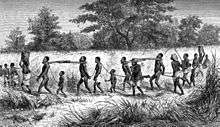
Livingstone believed that he had a spiritual calling for exploration to find routes for commercial trade which would displace slave trade routes, rather than for preaching. He was encouraged by the response in Britain to his discoveries and support for future expeditions, so he resigned from the London Missionary Society in 1857. According to his Victorian biographer W. Garden Blaikie, the reason was to prevent public concerns that his non-missionary activities such as his scientific work might show the LMS to be "departing from the proper objects of a missionary body". Livingstone had written to the directors of the society to express complaints about their policies and the clustering of too many missionaries near the Cape Colony, despite the sparse native population.[7] Blaikie, not wishing to offend Livingstone's relatives, still living in 1880 when his book was published, concealed the real reason why Livingstone left the LMS and the manner of it. In a letter from the directors of the LMS, which Livingstone received at Quelimane, he was congratulated on his journey but was told that the directors were "restricted in their power of aiding plans connected only remotely with the spread of the Gospel".[3]:156 This brusque rejection of his plan for new mission stations north of the Zambesi and his wider object of opening the interior via the Zambezi, was not enough to make him resign at once. When he was approached by Roderick Murchison, president of the Royal Geographical Society, who put him in touch with the Foreign Secretary, Livingstone said nothing to the LMS directors, even when his leadership of a government expedition to the Zambezi seemed increasingly likely to be funded by the Exchequer. "I am not yet fairly on with the Government," he told a friend, "but am nearly quite off with the Society (LMS)." And while he negotiated with the government, he deceived the LMS into thinking that he would return to Africa with their mission to the Kololo in Barotseland, which Livingstone had used his national fame to coerce them into initiating against their better judgement.[3]:169–171, 189 As biographer Tim Jeal shows in Chapter 12 of his biography, the end result would be the death of a missionary and his wife, the death of a second missionary's wife and the deaths of three children from malaria. Livingstone had suffered over thirty attacks during his journey but had deliberately understated his suffering so as not to discourage the LMS from sending missionaries to the Kololo. Consequently, the missionaries had set out for a marshy region with wholly inadequate supplies of quinine and they had soon weakened and died.[3]:159, 176–185
In May 1857 Livingstone was appointed as Her Majesty's Consul with a roving commission, extending through Mozambique to the areas west of it.[15]
Zambezi expedition
The British government agreed to fund Livingstone's idea and he returned to Africa as head of the Second Zambesi Expedition to examine the natural resources of southeastern Africa and open up the Zambezi River. However, it turned out to be completely impassable to boats past the Cahora Bassa rapids, a series of cataracts and rapids that Livingstone had failed to explore on his earlier travels.[14]
The expedition lasted from March 1858 until the middle of 1864. Expedition members recorded that Livingstone was an inept leader incapable of managing a large-scale project. He was also said to be secretive, self-righteous, and moody, and could not tolerate criticism, all of which severely strained the expedition and which led to his physician John Kirk writing in 1862, "I can come to no other conclusion than that Dr Livingstone is out of his mind and a most unsafe leader".[16]
Artist Thomas Baines was dismissed from the expedition on charges of theft (which he vigorously denied). The expedition became the first to reach Lake Malawi and they explored it in a four-oared gig. In 1862, they returned to the coast to await the arrival of a steam boat specially designed to sail on Lake Malawi. Mary Livingstone arrived along with the boat. She died on 27 April 1862 from malaria and Livingstone continued his explorations. Attempts to navigate the Ruvuma River failed because of the continual fouling of the paddle wheels from the bodies thrown in the river by slave traders, and Livingstone's assistants gradually died or left him.[16]
It was at this point that he uttered his most famous quotation, "I am prepared to go anywhere, provided it be forward." He eventually returned home in 1864 after the government ordered the recall of the expedition because of its increasing costs and failure to find a navigable route to the interior. The Zambezi Expedition was castigated as a failure in many newspapers of the time, and Livingstone experienced great difficulty in raising funds to further explore Africa. Nevertheless, John Kirk, Charles Meller, and Richard Thornton, the scientists appointed to work under Livingstone, did contribute large collections of botanical, ecological, geological, and ethnographic material to scientific Institutions in the United Kingdom.[16]
Nile River
In January 1866, Livingstone returned to Africa, this time to Zanzibar, and from there he set out to seek the source of the Nile. Richard Francis Burton, John Hanning Speke, and Samuel Baker had identified either Lake Albert or Lake Victoria as the source (which was partially correct, as the Nile "bubbles from the ground high in the mountains of Burundi halfway between Lake Tanganyika and Lake Victoria"[17]:384), but there was still serious debate on the matter. Livingstone believed that the source was farther south and assembled a team to find it consisting of freed slaves, Comoros Islanders, twelve Sepoys, and two servants from his previous expedition, Chuma and Susi.
Livingstone set out from the mouth of the Ruvuma river, but his assistants gradually began deserting him. The Comoros Islanders had returned to Zanzibar and (falsely) informed authorities that Livingstone had died. He reached Lake Malawi on 6 August, by which time most of his supplies had been stolen, including all his medicines. Livingstone then travelled through swamps in the direction of Lake Tanganyika, with his health declining. He sent a message to Zanzibar requesting that supplies be sent to Ujiji and he then headed west, forced by ill health to travel with slave traders. He arrived at Lake Mweru on 8 November 1867 and continued on, travelling south to become the first European to see Lake Bangweulu. Upon finding the Lualaba River, Livingstone theorised that it could have been the high part of the Nile River; but realised that it in fact flowed into the River Congo at Upper Congo Lake.[18]
The year 1869 began with Livingstone finding himself extremely ill while in the jungle. He was saved by Arab traders who gave him medicines and carried him to an Arab outpost.[19] In March 1869, Livingstone suffered from pneumonia and arrived in Ujiji to find his supplies stolen. He was coming down with cholera and had tropical ulcers on his feet, so he was again forced to rely on slave traders to get him as far as Bambara—where he was caught by the wet season. With no supplies, Livingstone had to eat his meals in a roped-off enclosure for the entertainment of the locals in return for food.[16]
On 15 July 1871,[20] he witnessed around 400 Africans being massacred by slavers while visiting Nyangwe on the banks of the Lualaba River.[21] The massacre horrified Livingstone, leaving him too shattered to continue his mission to find the source of the Nile.[20] Following the end of the wet season, he travelled 240 miles (390 km) from Nyangwe back to Ujiji, an Arab settlement on the eastern shore of Lake Tanganyika – violently ill most of the way – arriving on 23 October 1871.
Geographical discoveries
Livingstone was wrong about the Nile, but he identified numerous geographical features for Western science, such as Lake Ngami, Lake Malawi, and Lake Bangweulu, in addition to Victoria Falls mentioned above. He filled in details of Lake Tanganyika, Lake Mweru, and the course of many rivers, especially the upper Zambezi, and his observations enabled large regions to be mapped which previously had been blank. Even so, the farthest north he reached was the north end of Lake Tanganyika – still south of the Equator – and he did not penetrate the rainforest of the River Congo any further downstream than Ntangwe near Misisi.[22]
Livingstone was awarded the gold medal of the Royal Geographical Society of London and was made a Fellow of the society, with which he had a strong association for the rest of his life.[7]
Stanley meeting

_and_Henry_Morton_Stanley_(1841-1904)%2C_Africa%2C_ca._1875-ca._1940_(imp-cswc-GB-237-CSWC47-LS16-050).jpg)
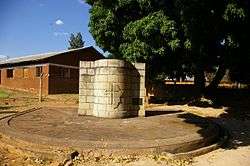
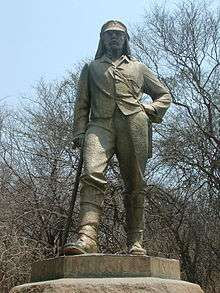
Livingstone completely lost contact with the outside world for six years and was ill for most of the last four years of his life. Only one of his 44 letter dispatches made it to Zanzibar. One surviving letter to Horace Waller was made available to the public in 2010 by its owner Peter Beard. It reads: "I am terribly knocked up but this is for your own eye only, ... Doubtful if I live to see you again ..."[23][24]
Henry Morton Stanley had been sent to find him by the New York Herald newspaper in 1869. He found Livingstone in the town of Ujiji on the shores of Lake Tanganyika on 10 November 1871,[25] greeting him with the now famous words "Dr Livingstone, I presume?" Livingstone responded, "Yes", and then "I feel thankful that I am here to welcome you." These famous words may have been a fabrication, as Stanley later tore out the pages of this encounter in his diary.[26] Even Livingstone's account of this encounter does not mention these words. However, the phrase appears in a New York Herald editorial dated 10 August 1872, and the Encyclopædia Britannica and the Oxford Dictionary of National Biography both quote it without questioning its veracity. The words are famous because of their perceived humour, Livingstone being the only other white person for hundreds of miles. Stanley's book suggests that it was really because of embarrassment because he did not dare to embrace him.
Despite Stanley's urgings, Livingstone was determined not to leave Africa until his mission was complete. His illness made him confused and he had judgement difficulties at the end of his life. He explored the Lualaba and, failing to find connections to the Nile, returned to Lake Bangweulu and its swamps to explore possible rivers flowing out northwards.[19]
Christianity and Sechele
Livingstone is known as "Africa's greatest missionary," yet he is recorded as having converted only one African: Sechele, who was the chief of the Kwena people of Botswana (Kwena are one of the main Sotho-Tswana clans, found in South Africa, Lesotho, and Botswana[27] in all three Sotho-Tswana language groupings). Sechele was born in 1812. His father died when Sechele was 10, and two of his uncles divided the tribe, which forced Sechele to leave his home for nine years. When Sechele returned, he took over one of his uncle's tribes; at that point, he met David Livingstone.[6] Livingstone was known through a large part of Africa for treating the natives with respect, and the tribes that he visited returned his respect with faith and loyalty. He could never permanently convert the tribesmen to Christianity, however. Among other reasons, Sechele, by then the leader of the African tribe, did not like the way that Livingstone could not demand rain of his God like his rainmakers, who said that they could. After long hesitation from Livingstone, he baptised Sechele and had the church completely embrace him. Sechele was now a part of the church, but he continued to act according to his African culture, which went against Livingstone's teachings.[28]:20
Sechele was no different from any other man of his tribe in believing in polygamy. He had five wives, and when Livingstone told him to get rid of four of them, it shook the foundations of the Kwena tribe. After he finally divorced the women, Livingstone baptised them all and everything went well. However, one year later one of his ex-wives became pregnant and Sechele was the father. Sechele begged Livingstone to not give up on him because his faith was still strong, but Livingstone left the country and went north to continue his Christianizing attempts.[13]
Livingstone immediately interested Sechele, and especially his ability to read. Being a quick learner, Sechele learned the alphabet in two days and soon called English a second language. After teaching his wives the skill, he wrote the Bible in his native tongue.[29]
After Livingstone left the Kwena tribe, Sechele remained faithful to Christianity and led missionaries to surrounding tribes as well as converting nearly his entire Kwena people. In the estimation of Neil Parsons of the University of Botswana, Sechele "did more to propagate Christianity in 19th-century southern Africa than virtually any single European missionary". Although Sechele was a self-proclaimed Christian, many European missionaries disagreed. The Kwena tribe leader kept rainmaking a part of his life as well as polygamy.[27]
Death
_-_Copy.jpg)
David Livingstone died in 1873 at the age of 60 in Chief Chitambo's village at Ilala, southeast of Lake Bangweulu, in present-day Zambia, from malaria and internal bleeding due to dysentery. His loyal attendants Chuma and Susi removed his heart and buried it under a tree near the spot where he died, which has been identified variously as a Mvula tree or a Baobab tree.[31][32]:147 That site, now known as the Livingstone Memorial,[33] lists his date of death as 4 May, the date reported (and carved into the tree's trunk) by Chuma and Susi; but most sources consider 1 May—the date of Livingstone's final journal entry—as the correct one.[19]:242–244
The rest of his remains were carried, together with his journal, over 1,000 miles (1,600 km) by Chuma and Susi to the coastal town of Bagamoyo, where they were returned by ship to Britain for burial. In London, his body lay in repose at No.1 Savile Row, then the headquarters of the Royal Geographical Society, prior to interment at Westminster Abbey.[7][34][35]
Livingstone and slavery
_by_The_London_Missionary_Society.jpg)
And if my disclosures regarding the terrible Ujijian slavery should lead to the suppression of the East Coast slave trade, I shall regard that as a greater matter by far than the discovery of all the Nile sources together.
— Livingstone in a letter to the editor of the New York Herald[25]
Livingstone wrote of the slave trade in the African Great Lakes region, which he visited in the mid-nineteenth century:
We passed a slave woman shot or stabbed through the body and lying on the path. [Onlookers] said an Arab who passed early that morning had done it in anger at losing the price he had given for her, because she was unable to walk any longer.[19]:46
Livingstone's letters, books, and journals[19] did stir up public support for the abolition of slavery;[1] however, he became dependent for assistance on the very slave-traders whom he wished to put out of business. He was a poor leader of his peers, and he ended up on his last expedition as an individualist explorer with servants and porters but no expert support around him. At the same time, he did not use the brutal methods of maverick explorers such as Stanley to keep his retinue of porters in line and his supplies secure. For these reasons, he accepted help and hospitality from 1867 onwards from Mohamad Bogharib and Mohamad bin Saleh (also known as "Mpamari"), traders who kept and traded in slaves, as he recounts in his journals. They, in turn, benefited from Livingstone's influence with local people, which facilitated Mpamari's release from bondage to Mwata Kazembe. Livingstone was furious to discover that some of the replacement porters sent at his request from Ujiji were slaves.[19]
Legacy
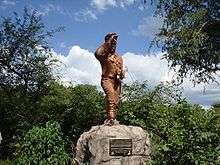
By the late 1860s Livingstone's reputation in Europe had suffered owing to the failure of the missions he set up, and of the Zambezi Expedition; and his ideas about the source of the Nile were not supported. His expeditions were hardly models of order and organisation. His reputation was rehabilitated by Stanley and his newspaper,[14] and by the loyalty of Livingstone's servants whose long journey with his body inspired wonder. The publication of his last journal revealed stubborn determination in the face of suffering.[7]
In 1860, the Universities' Mission to Central Africa was founded at his request. Many important missionaries, such as Leader Stirling and Miss Annie Allen, would later work for this group. This group and the medical missionaries it sponsored came to have major, positive impact on the people of Africa.[36]
Livingstone made geographical discoveries for European knowledge. He inspired abolitionists of the slave trade, explorers, and missionaries. He opened up Central Africa to missionaries who initiated the education and healthcare for Africans, and trade by the African Lakes Company. He was held in some esteem by many African chiefs and local people and his name facilitated relations between them and the British.[7]
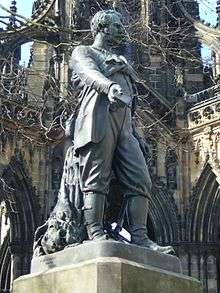
Partly as a result, within 50 years of his death, colonial rule was established in Africa, and white settlement was encouraged to extend further into the interior. However, what Livingstone envisaged for "colonies" was not what we now know as colonial rule, but rather settlements of dedicated Christian Europeans who would live among the people to help them work out ways of living that did not involve slavery.[13] Livingstone was part of an evangelical and nonconformist movement in Britain which during the 19th century helped change the national mindset from the notion of a divine right to rule 'lesser races', to more modernly ethical ideas in foreign policy.[37]
The David Livingstone Centre in Blantyre celebrates his life and is based in the house in which he was born, on the site of the mill in which he started his working life. His Christian faith is evident in his journal, in which one entry reads: "I place no value on anything I have or may possess, except in relation to the kingdom of Christ. If anything will advance the interests of the kingdom, it shall be given away or kept, only as by giving or keeping it I shall promote the glory of Him to whom I owe all my hopes in time and eternity."[38]
In 2002, David Livingstone was named among the 100 Greatest Britons following a UK-wide vote.[39]
Family life
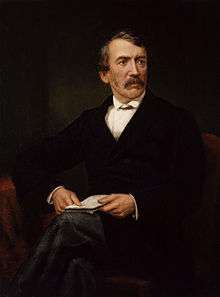
While Livingstone had a great impact on British Imperialism, he did so at a tremendous cost to his family. In his absences, his children grew up missing their father, and his wife Mary (daughter of Mary and Robert Moffat), whom he wed in 1845, endured very poor health, and died of malaria on 27 April 1862[40] trying to follow him in Africa.
He had six children:
- Robert died in the American Civil War;[41] He took the name Rupert Vincent and was the substitute for Horace Heath, and took his place in Company H of the 3rd New Hampshire Volunteers. Robert ended up being captured and he died at the Salisbury POW camp in North Carolina.[42]
- Agnes (born 1847)
- Thomas
- Elizabeth (who died at two months)
- William Oswell (nicknamed Zouga because of the river along which he was born, in 1851)
- Anna Mary (born 1858)
Only Agnes, William Oswell and Anna Mary married and had children.[43] His one regret in later life was that he did not spend enough time with his children.[44]
Online and manuscript archives
Over the last decade, the groundbreaking project Livingstone Online, a digital museum and library, has made Livingstone's written and visual legacies accessible to a wide international audience through the site's digital collection. This project is directed from the University of Nebraska and is led by Professor Adrian S. Wisnicki (University of Nebraska-Lincoln) and Professor Megan Ward (Oregon State University). The site was founded by Professor Christopher Lawrence and was originally based at University College London. At present, Livingstone Online:
- publishes an array of critical essays on the colonial archive, the history of nineteenth-century Africa, British imperial discourse, and Livingstone's manuscripts;
- offers open access to over 15,000 images of manuscripts and historical illustrations, 5,000 pages of critically edited and encoded transcriptions, and 3,000 metadata records;
- includes digital humanities process narratives and hundreds of project documents that take users far behind the scenes of the research that has made the project possible.
Livingstone Online also includes a number of critical editions focused on specific manuscripts or collections of documents. A handful of the editions draw on state-of-the-art spectral imaging technology, an area where the Livingstone Online team has been recognized for its disciplinary leadership.

The editions are as follows:
- Ward, Megan, and Adrian S. Wisnicki, dirs. Livingstone's Final Manuscripts (1865-1873) – Diaries, Journals, Notebooks, and Maps: A Critical Edition. First edition, 2018.
- McDonald, Jared, and Adrian S. Wisnicki, dirs. Livingstone’s Manuscripts in South Africa (1843-1872): A Critical Edition. First edition, 2018.
- Wisnicki, Adrian S., and Megan Ward, dirs. Livingstone’s 1870 Field Diary and Select 1870-1871 Manuscripts: A Multispectral Critical Edition. First edition, 2017.
- Wisnicki, Adrian S., dir. Livingstone’s 1871 Field Diary: A Multispectral Critical Edition. Updated version, 2017.
- Wisnicki, Adrian S., dir. Livingstone’s Letter from Bambarre: A Multispectral Critical Edition. Updated version, 2017.
Finally, Livingstone Online also enumerates the international array of archives, libraries, and museums that hold original Livingstone documents around the world. Some of the most important institutions with original manuscript holdings include the David Livingstone Centre, National Library of Scotland, the Royal Geographical Society, SOAS, University of London, the Wellcome Institute for the History of Medicine Library, the Livingstone Museum in Zambia and the Brenthurst Library in South Africa.
Places named in his honour and other memorials
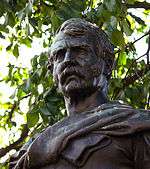
.jpg)
Africa
- The Livingstone Memorial in Ilala, Zambia marks where David Livingstone died
- The city of Livingstone, Zambia, which includes a memorial in front of the Livingstone Museum and a new statue erected in 2005.[45]
- The Rhodes–Livingstone Institute in Livingstone and Lusaka, Zambia, 1940s to 1970s, was a pioneering research institution in urban anthropology.
- David Livingstone Teachers' Training College, Livingstone, Zambia.
- The David Livingstone Memorial statue at Victoria Falls, Zimbabwe, erected in 1934 on the western bank of the falls.[46]Michler 2007 quoted 1954 which is wrong. The statue was unveiled on 5 August 1934[47]
- A new statue of David Livingstone was erected in November 2005 on the Zambian side of Victoria Falls.[45]
- A plaque was unveiled in November 2005 at Livingstone Island on the lip of Victoria Falls marking where Livingstone stood to get his first view of the falls.[45]
- Livingstone Hall, Men's Hall of residence at Makerere University, Kampala, Uganda.
- The town of Livingstonia, Malawi.
- The city of Blantyre, Malawi is named after Livingstone's birthplace in Scotland, and includes a memorial.
- The David Livingstone Scholarships for students at the University of Malawi, funded through Strathclyde University, Scotland.
- The David Livingstone Clinic was founded by the University of Strathclyde's Millennium Project in Lilongwe, Malawi.[48]
- The Kipengere Range in south-west Tanzania at the north-eastern end of Lake Malawi is also called the Livingstone Mountains.
- Livingstone Falls on the River Congo, named by Stanley.
- The Livingstone Inland Mission, a Baptist mission to the Congo Free State 1877–1884, located in present-day Kinshasa, Zaire.
- A memorial in Ujiji commemorates his meeting with Stanley.
- The Livingstone–Stanley Monument in Mugere (present-day Burundi) marks a spot that Livingstone and Stanley visited on their exploration of Lake Tanganyika, mistaken by some as the first meeting place of the two explorers.
- Scottish Livingstone Hospital in Molepolole 50 km west of Gaborone, Botswana
- There is a memorial to Livingstone at the ruins of the Kolobeng Mission, 40 km west of Gaborone, Botswana.
- The church tower of the Holy Ghost Mission (Roman Catholic) in Bagamoyo, Tanzania, is sometimes called "Livingstone Tower" as Livingstone's body was laid down there for one night before it was shipped to London.
- Livingstone House in Stone Town, Zanzibar, provided by the Sultan for Livingstone's use, January to March 1866, to prepare his last expedition; the house was purchased by the Zanzibar government in 1947.
- Plaque commemorating his departure from Mikindani (present-day Tanzania) on his final expedition on the wall of the house that has been built over the house he reputedly stayed in.
- David Livingstone Primary School in Salisbury, Rhodesia (present-day Harare, Zimbabwe).
- Dr Livingstone Primary School in Nairobi, Kenya.[49]
- David Livingstone Secondary School in Ntabazinduna about 40 km from Bulawayo, Zimbabwe.
- David Livingstone Senior Secondary School in Schauderville, Port Elizabeth, South Africa.
- Livingstone House in Harare, Zimbabwe, designed by Leonora Granger.
- Livingstone House, Achimota School, Ghana (boys' boarding house).
- Livingstone Street, Dar es Salaam, Tanzania.
- David Livingstone Museum in Sangwali, north-eastern Namibia. Livingstone stayed at Sangwali in the 1850s before travelling further north.[50]
- Livingstone Kolobeng College, a private secondary school in Gaborone, Botswana.
New Zealand
- Livingstone Street in Westmere, Auckland
- Livingstone Road in Flaxmere, Hastings
Antarctica
- Livingstone Island at the western tip of the Antarctic Peninsula
Scotland
- The David Livingstone Centre in Blantyre, Scotland, is a museum in his honour. This is operated by the David Livingstone Trust
- David Livingstone Memorial Primary School in his birthplace, Blantyre, Lanarkshire, Scotland.
- David Livingstone Memorial Church of the Church of Scotland, in Blantyre, Lanarkshire, Scotland.
- A statue of Livingstone is sited in Cathedral Square, Glasgow.
- A bust of David Livingstone is among those of famous Scotsmen in the William Wallace Memorial near Stirling, Scotland.
- Strathclyde University, Glasgow (which evolved from Anderson's University, later the Royal College of Science and Technology), commemorates him in the David Livingstone Centre for Sustainability[51] and the Livingstone Tower where there is a statue of him in the building's foyer.
- The David Livingstone Room in the Royal College of Physicians and Surgeons of Glasgow.[52] A portrait of Livingstone by Thomas Annan (a photograph painted over in oils) hangs outside the room.[53]
- The David Livingstone (Anderson College) Memorial Prize in Physiology commemorates him at the University of Glasgow.
- Livingstone Place, a street in the Marchmont neighbourhood of Edinburgh.
- Livingstone Street in Addiewell.
- A memorial plaque commemorating the centenary of Livingstone's birth was dedicated in St. James's Congregational Church, the church he attended as a boy.[54]
London
- A statue of David Livingstone stands in a niche on the outer wall of the Royal Geographical Society on Kensington Gore, London, looking out across Kensington Gardens. It was unveiled in 1953.[55]
Canada
- The Livingstone Range of mountains in southern Alberta.
- David Livingstone Elementary School, Vancouver.
- David Livingstone Community School, Winnipeg.
- Bronze bust in Halifax, Nova Scotia.
- Gold bust in the city of Borden, Ontario.
- Livingstone Avenue in Barrie, Ontario.
- Livingstone Street, St. John's, Newfoundland and Labrador, Canada.
United States
- The town of Livingston, California
- Livingstone College, Salisbury, North Carolina.
- Livingstone Adventist Academy, Salem, Oregon.
Livingston Falls, Busch Gardens, Tampa Bay
South America
- The Livingstone Healthservice in Jardìn Amèrica, Misiones, Argentina is named in his honour.[56]
Banknotes
In 1971–1998 Livingstone's image was portrayed on £10 notes issued by the Clydesdale Bank. He was originally shown surrounded by palm tree leaves with an illustration of African tribesmen on the back.[57] A later issue showed Livingstone against a background graphic of a map of Livingstone's Zambezi expedition, showing the River Zambezi, Victoria Falls, Lake Nyasa and Blantyre, Malawi; on the reverse, the African figures were replaced with an image of Livingstone's birthplace in Blantyre, Scotland.[58]
Biology
The following species have been named in honour of David Livingstone:
- Livingston's cichlid, Nimbochromis livingstonii
- Livingstone's eland, Taurotragus oryx livingstonii
- Livingstone's fruit bat, Pteropus livingstonii
Portrayal in film
Livingstone has been portrayed by M.A. Wetherell in Livingstone (1925), Percy Marmont in David Livingstone (1936), Sir Cedric Hardwicke in Stanley and Livingstone (1939), Bernard Hill in Mountains of the Moon (1990) and Sir Nigel Hawthorne in the TV movie Forbidden Territory (1997).[59]
The 1949 comedy film Africa Screams is the story of a dimwitted clerk named Stanley Livington (played by Lou Costello), who is mistaken for a famous African explorer and recruited to lead a treasure hunt. The character's name appears to be a play on Stanley and Livingstone, but with a few crucial letters omitted from the surname; it is unknown whether this results from a typist's error or a deliberate obfuscation.
In popular culture
The ABBA song "What about Livingstone?"[60] mentions Livingstone traveling up the Nile.
Stanley's search for and discovery of Livingstone is the subject of the Hugh Masekela song "Whitch Doctor" that appears on his 1976 album, Colonial Man.
There is an achievement in Sid Meier's Civilization 5 called "Dr Livingstone I presume?" in which the player needs to move his/her Stanley Explorer into a tile of England's Livingstone Explorer.
See also
Notes
- 1 2 "David Livingstone (1813 - 1873)". BBC - History - Historic Figures. 2014. Retrieved 2018-07-12.
- ↑ Easton, Mark (3 September 2017). "Why don't many British tourists visit Victoria Falls?". BBC News. Retrieved 2018-07-12.
- 1 2 3 4 5 6 7 8 9 10 11 12 Jeal, Tim (2013). Livingstone: Revised and Expanded Edition. Yale University Press. ISBN 978-0-300-19100-4.
- ↑ Mackenzie, John M. (1990). "David Livingstone: The Construction of the Myth". In Walker, Graham; Gallagher, Tom. Sermons and battle hymns: Protestant popular culture in modern Scotland. Edinburgh University Press. ISBN 978-0-7486-0217-9.
- ↑ "Archived copy". Archived from the original on 12 February 2007. Retrieved 12 July 2018.
- 1 2 Ross, Andrew C. (2006). David Livingstone: Mission and Empire. A&C Black. ISBN 978-1-85285-565-9.
- 1 2 3 4 5 6 7 8 9 10 11 12 Blaikie, William Garden (1880). The Personal Life of David Livingstone... Chiefly from His Unpublished Journals and Correspondence in the Possession of His Family. London: John Murray – via Project Gutenberg.
- 1 2

- ↑ "The University of Glasgow Story : David Livingstone". University of Glasgow. n.d. Retrieved 2018-07-12.
- ↑ Duncan, Alexander (1896). Memorials of the Faculty of Physicians and Surgeons of Glasgow, 1599–1850. Glasgow: MacLehose. pp. 100, 293.
- ↑ Harrison, Eugene Myers (1954). "David Livingstone: The Pathfinder of Africa". Giants of the Missionary Trail: The Life Stories of Eight Men who Defied Death and Demons. Scripture Press.
- ↑ Livingstone, David (1960). Isaac Schapera, ed. Livingstone's private journals, 1851-1853. University of California Press. p. 304.
- 1 2 3 Tomkins, Stephen (2013). David Livingstone: The Unexplored Story. Lion Books. ISBN 978-0-7459-5568-1.
- 1 2 3 Holmes, Tim (1996). "The History". Spectrum Guide to Zambia. Struik. ISBN 978-1-86872-012-5.
- ↑ Livingstone to Lord Clarendon 19 March 1857 Clarendon Papers Bodleian Library Dep. c 80
- 1 2 3 4 Wright, Ed (2008). Lost Explorers: Adventurers who Disappeared Off the Face of the Earth. Allen & Unwin. ISBN 978-1-74196-139-3.
- ↑ Dugard, Martin (2012). Into Africa: The Epic Adventures Of Stanley And Livingstone. Transworld. ISBN 978-1-4464-3720-9.
- ↑ Livingstone, David. "Personal Letter to J. Kirk or R. Playfair". David Livingstone Online. Archived from the original on 21 December 2014. Retrieved 10 December 2014.
- 1 2 3 4 5 6 Livingstone, David (1874). Waller, Horace, ed. The Last Journals of David Livingstone, in Central Africa, from 1865 to His Death: Continued by a Narrative of His Last Moments and Sufferings, Obtained from His Faithful Servants Chuma and Susi ; in Two Volumes. J. Murray.
- 1 2 Livingstone, David (2011). Wisnicki, Adrian S., ed. Livingstone's 1871 Field Diary: A Multispectral Critical Edition. UCLA Library.
- ↑ Jeal, Tim (1973). Livingstone. New Haven, CT: Yale University Press. pp. 331–335. OCLC 689879.
- ↑ "Map of Livingstone's travels", National Museums of Scotland. The map is online here (subscription required)
- ↑ "David Livingstone letter deciphered at last. Four-page missive composed at the lowest point in his professional life". Associated Press. 2 July 2010. Retrieved 2 July 2010.
- ↑ Livingstone's Letter from Bambarre, emelibrary.org; accessed 4 July 2010.
- 1 2 Stanley, Henry Morton (1872). How I Found Livingstone: Travels, Adventures and Discoveries in Central Africa: Including an Account of Four Months' Residence with Dr. Livingstone. Scribner, Armstrong & Company.
- ↑ Jeal, Tim (2007). Stanley: The Impossible Life of Africa's Greatest Explorer. Yale University Press. ISBN 978-0-300-12625-9.
- 1 2 Tomkins, Stephen (19 March 2013). "The African chief converted to Christianity by Dr Livingstone". BBC News. Retrieved 2018-07-12.
- ↑ Horne, C. Silvester (1999). David Livingstone: Man of Prayer and Action. Christian Liberty Press. ISBN 978-1-930092-11-2.
- ↑ Livingstone, David (1857). Missionary Travels and Researches in South Africa: Including a Sketch of Sixteen Years' Residence in the Interior of Africa. London: Murray. p. 16.
- ↑ Wyon, Allen (February 1890). "A Livingstone Medal". Chronicles of the London Missionary Society. London: 60.
- ↑ Wickens, G.E.; Lowe, P. (2008). The Baobabs: Pachycauls of Africa, Madagascar and Australia. Springer Netherlands. p. 33. ISBN 978-1-4020-6430-2.
- ↑ Dugard, Martin (2014). The Explorers: A Story of Fearless Outcasts, Blundering Geniuses, and Impossible Success. Simon and Schuster. ISBN 978-1-4516-7757-7.
- ↑ Bradford, Charles Angell (1933). Heart Burial. London: Allen & Unwin. p. 242. OCLC 10641494.
- ↑ G. Bruce Boyer (Summer 1996). "On Savile Row". Cigar Aficionado. Archived from the original on 17 August 2010. Retrieved 21 December 2009.
- ↑ David Livingstone. Westminster-abbey.org, retrieved 23 October 2015.
- ↑ Stirling, Leader (1977). Tanzanian Doctor. Montreal: McGill-Queen's University Press. ISBN 978-0-7735-9393-0.
- ↑ Barnett, Correlli (1986). The Audit of War: The Illusion and Reality of Britain as a Great Nation. MacMillan. ISBN 978-0-333-35376-9.
- ↑ Neill, Stephen; Chadwick, Owen (1990). A History of Christian Missions. Penguin Books. p. 315. ISBN 978-0-14-013763-7.
- ↑ "Archived copy". Archived from the original on 4 December 2002. Retrieved 19 July 2017.
- ↑ "Obituaries". Appletons' annual cyclopaedia and register of important events of the year: 1862. New York: D. Appleton & Company. 1863. p. 687.
- ↑ Chirgwin, A. M. (1934). "New Light on Robert Livingstone". Journal of the Royal African Society. 33 (132): 250–252. JSTOR 716469.
- ↑ Murray, John (August 2011). "Rupert Vincent, I Presume?". Crossfire. Retrieved 2018-07-12.
- ↑ Steven Wilson. "Livingstone Descendants". Freepages.genealogy.rootsweb.ancestry.com. Retrieved 23 January 2012.
- ↑ Ferguson, Niall (2002). Empire: The Rise and Demise of the British World Order and the Lessons for Global Power. Basic Books. p. 158. ISBN 978-0-465-02329-5.
- 1 2 3 "Archived copy". Archived from the original on 27 September 2007. Retrieved 27 April 2007.
- ↑ Michler, Ian (2007). Victoria Falls & Surrounds: The Insider's Guide. Penguin. p. 11. ISBN 978-1-77007-361-6.
- ↑ David Livingstone's statue. Victoria Falls. 1934.
- ↑ David Livingstone Clinic webpage
- ↑ http://dr.livingstone.primary.school.co.ke/
- ↑ Lottering, Francois (28 October 2016). "Museum to honour David Livingstone". The Namibian. p. 7.
- ↑ David Livingstone Centre for Sustainability webpage Archived 7 August 2012 at the Wayback Machine.
- ↑ "David Livingstone Meeting & Function Room | Fifteen Ninety Nine". fifteenninetynine.co.uk. Retrieved 23 August 2016.
- ↑ Andrew McAinsh (5 January 2016). "Thomas Annan and the Documentary Photograph". College Library. Retrieved 23 August 2016.
- ↑ "David Livingstone – a brief history". Hamilton.urc.org.uk. 13 January 2012. Retrieved 7 March 2013.
- ↑ "Unveiling of the Livingstone Statute". The Geographical Journal. 120 (1): 15. 1954. doi:10.2307/1791984. ISSN 0016-7398.
- ↑ Livingstone Healthservice
- ↑ "Clydesdale 10 Pounds, 1982". Ron Wise's Banknoteworld. Archived from the original on 21 October 2008. Retrieved 15 October 2008.
- ↑ "Clydesdale 10 Pounds, 1990". Ron Wise's Banknoteworld. Archived from the original on 21 October 2008. Retrieved 15 October 2008.
- ↑ Forbidden Territory: Stanley's Search for Livingstone (1997) on IMDb
- ↑ Sheridan, Simon (2012). The Complete ABBA (40th Anniversary Edition). Titan Books. p. 69. ISBN 978-0857687241.
Sources
- Milbrandt, Jay (2014). The Daring Heart of David Livingstone: Exile, African Slavery, and the Publicity Stunt that Saved Millions. Nashville, TN: Thomas Nelson. ISBN 978-1-59555-592-2. scholarly biography
- Holmes, Timothy (1993). Journey to Livingstone: Exploration of an Imperial Myth. Edinburgh: Canongate Press. ISBN 978-0-86241-402-3; scholarly biography
- Jeal, Tim (1973). Livingstone. London, UK: Heinemann. ISBN 0-434-37208-0. , scholarly biography
- Livingstone, David (1905) [1857]. Journeys in South Africa, or Travels and Researches in South Africa. London, UK: The Amalgamated Press Ltd.
- Livingstone, David and James I. Macnair (eds) (1954). Livingstone's Travels. London, UK: J.M. Dent.
- Livingstone, David (1999) [1875]. Dernier Journal. Paris: Arléa; ISBN 2-86959-215-9 (in French)
- Maclachlan, T. Banks. David Livingstone, Edinburgh: Oliphant, Anderson and Ferrier, 1901, ("Famous Scots Series").
- Martelli, George (1970). Livingstone's River: A History of the Zambezi Expedition, 1858–1864. London: Chatto & Windus. ISBN 978-0-7011-1527-2
- Morrill, Leslie, and Madge Haines (1959). Livingstone, Trail Blazer for God. Mountain View: Pacific Press Publication Association.
- Philip, M. NourbeSe (1991). Looking for Livingstone: An Odyssey of Silence. Stratford: The Mercury Press; ISBN 978-0-920544-88-4
- Ross, Andrew C. (2002). David Livingstone: Mission and Empire. London and New York: Hambledon and London; ISBN 978-1-85285-285-6
- Seaver, George. David Livingston: His Life and Letters (1957), a standard biography
- Waters, John (1996). David Livingstone: Trail Blazer. Leicester: Inter-Varsity; ISBN 978-0-85111-170-4
- Wisnicki, Adrian S. (2009). "Interstitial Cartographer: David Livingstone and the Invention of South Central Africa". Victorian Literature and Culture 37.1 (Mar.): 255–71.
External links
| Wikiquote has quotations related to: David Livingstone |
| Wikisource has original works written by or about: David Livingstone |
- Livingstone Spectral Imaging Project. Many of Livingstone's original papers spectrally imaged.
- Livingstone Online – Explore the manuscripts of David Livingstone Images of original documents alongside transcribed, critically edited versions
- David Livingstone (c. 1956). Archive film from the National Library of Scotland: Scottish Screen Archive
- Works by David Livingstone at Project Gutenberg
- Works by or about David Livingstone at Internet Archive
- A Brief Biography of David Livingstone
- David Livingstone biographies
- "Dr. Livingston (obituary, Wed., 28 Jan. 1874)". Eminent persons: Biographies reprinted from the Times. Vol. 1–6. D. Vol I, 1870–1875. Macmillan & Co.: 225–236 1892
- The Lost Diary of Dr. Livingstone Documentary produced by the PBS Series Secrets of the Dead
- How Livingstone discovered the Falls. by J. Desmond Clark M.A. PH.D. F.S.A. Curator of the Rhodes-Livingstone Museum. 1955
- Interactive map of Dr. Livingstone's Zambezi expedition
- Newspaper clippings about David Livingstone in the 20th Century Press Archives of the German National Library of Economics (ZBW)